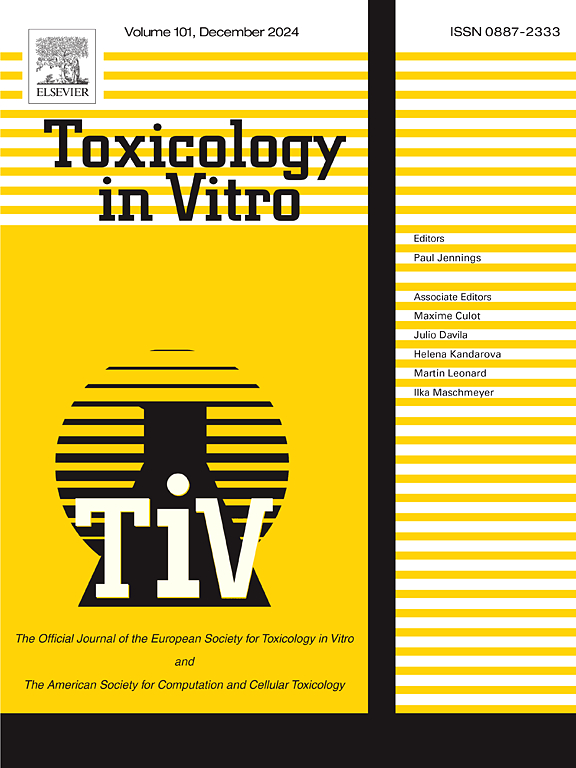Development of skin corrosion and irritation test methods employing ex vivo porcine skin model
IF 2.6
3区 医学
Q3 TOXICOLOGY
引用次数: 0
Abstract
Skin corrosion and irritation are key local toxicological responses of the skin to chemical exposure. Conventional in vivo methods have limitations such as species difference, ethical concern, and reproducibility issue, necessitating the development of reliable alternatives. We developed skin corrosion (SCT) and irritation test (SIT) methods using ex vivo porcine ear skin based on cell viability and skin barrier disruption. Test chemicals were treated on ex vivo porcine ear skin for 3 min and 60 min (SCT) or 60 min only (SIT). After 40 ± 2 h post-incubation, cell viability assay with CCK-8, and skin barrier test with FITC-dextran penetration were conducted. To evaluate the predictive capacity of the method, 38 reference chemicals (20 corrosives, 8 irritants and 10 no category chemicals) were tested. SCT achieved 96.7 % (29/30) accuracy in identifying corrosives, meeting the performance standards of OECD TG 431 In Vitro Skin Corrosion: Reconstructed Human Epidermis test. The accuracy for subcategorizing corrosive substances into categories 1 A (<25 % at 3 min) and 1B/1C (≥25 % at 3 min, <25 % at 60 min) was 83.3 % (25/30). The accuracy of SIT identifying non-irritant (≥50 % at 60 min) was 83.3 % (15/18). FITC-dextran penetration assay showed a similar accuracy, highlighting its value as an alternative endpoint to identify irritants. Collectively, this study demonstrated that the ex vivo porcine skin model may offer a cost-effective, and reliable alternative for skin hazard testing.
用离体猪皮肤模型建立皮肤腐蚀和刺激试验方法。
皮肤腐蚀和刺激是皮肤对化学物质暴露的主要局部毒理学反应。传统的体内方法存在物种差异、伦理问题和可重复性问题等局限性,需要开发可靠的替代方法。我们开发了基于细胞活力和皮肤屏障破坏的体外猪耳皮肤皮肤腐蚀(SCT)和刺激试验(SIT)方法。试验化学品在离体猪耳皮肤上处理3 min和60 min (SCT)或60 min (SIT)。孵育40 ± 2 h后,进行CCK-8细胞活力测定和fitc -葡聚糖渗透皮肤屏障试验。为了评估该方法的预测能力,测试了38种标准化学品(20种腐蚀性化学品,8种刺激物和10种无类别化学品)。SCT鉴定腐蚀物的准确率达到96.7 %(29/30),符合OECD TG 431体外皮肤腐蚀:重建人体表皮试验的性能标准。将腐蚀性物质划分为第一类的准确性 A (
本文章由计算机程序翻译,如有差异,请以英文原文为准。
求助全文
约1分钟内获得全文
求助全文
来源期刊

Toxicology in Vitro
医学-毒理学
CiteScore
6.50
自引率
3.10%
发文量
181
审稿时长
65 days
期刊介绍:
Toxicology in Vitro publishes original research papers and reviews on the application and use of in vitro systems for assessing or predicting the toxic effects of chemicals and elucidating their mechanisms of action. These in vitro techniques include utilizing cell or tissue cultures, isolated cells, tissue slices, subcellular fractions, transgenic cell cultures, and cells from transgenic organisms, as well as in silico modelling. The Journal will focus on investigations that involve the development and validation of new in vitro methods, e.g. for prediction of toxic effects based on traditional and in silico modelling; on the use of methods in high-throughput toxicology and pharmacology; elucidation of mechanisms of toxic action; the application of genomics, transcriptomics and proteomics in toxicology, as well as on comparative studies that characterise the relationship between in vitro and in vivo findings. The Journal strongly encourages the submission of manuscripts that focus on the development of in vitro methods, their practical applications and regulatory use (e.g. in the areas of food components cosmetics, pharmaceuticals, pesticides, and industrial chemicals). Toxicology in Vitro discourages papers that record reporting on toxicological effects from materials, such as plant extracts or herbal medicines, that have not been chemically characterized.
 求助内容:
求助内容: 应助结果提醒方式:
应助结果提醒方式:


